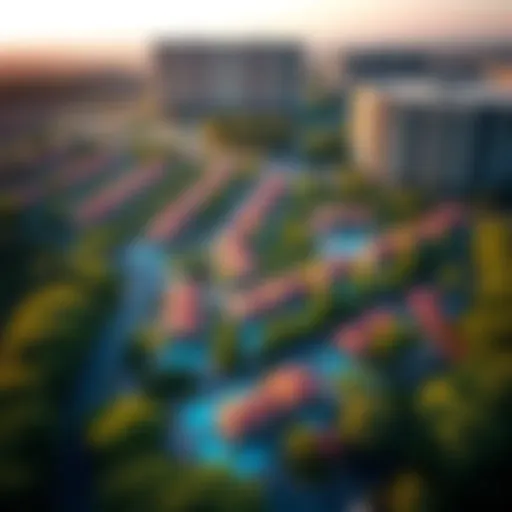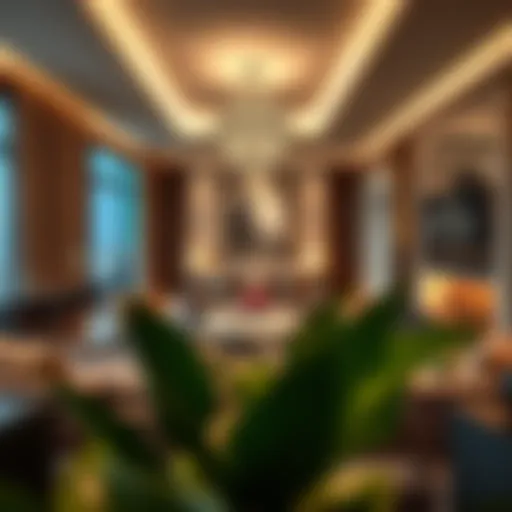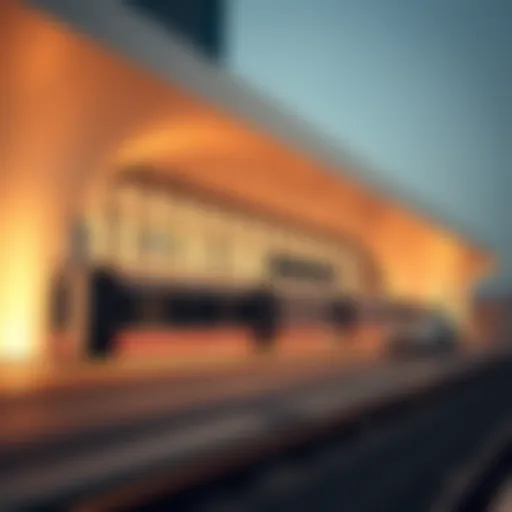Exploring the Al Jaziri Building: A Dubai Landmark
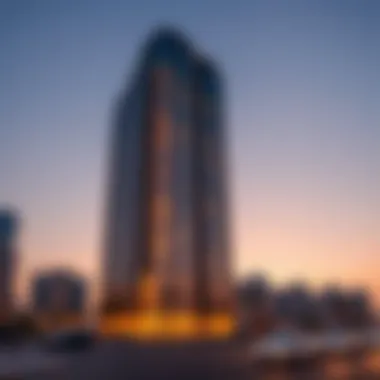

Market Insights
The Al Jaziri Building is not just an architectural marvel; it is a key player in Dubai's ongoing real estate transformation. As developers continue to innovate and push boundaries, understanding the current landscape is crucial for potential investors and stakeholders alike.
Current Trends in Dubai Real Estate
Dubai's property market is in a constant state of flux, driven by both local and international trends. The recent surge in demand for luxury residential units has been remarkable. From high-end apartments in the Marina district to lavish villas on Palm Jumeirah, properties offering exceptional amenities are hot commodities. With the influx of expatriates seeking new lifestyles and opportunities, real estate in Dubai increasingly serves as both a personal haven and a lucrative investment.
On another front, sustainability has made its mark. Many new developments are incorporating eco-friendly technologies, aiming for a minimal environmental footprint. The Al Jaziri Building itself showcases modern sustainable features that align with Dubai's vision for a greener future.
Residential properties accounted for nearly % of real estate transactions in Dubai in the past year, signaling strong buyer confidence.
Forecasting Future Market Changes
Looking ahead, experts predict continued growth in Dubai's real estate sector. With major projects like the Dubai Creek Tower and Expo 2020 drawing global attention, the demand for commercial and residential spaces is set to rise. The Al Jaziri Building stands as a testament to this growth, providing investors not just a property, but a stake in an ever-evolving market.
Moreover, the integration of smart home technologies is expected to influence buyer preferences significantly. As tech-savvy generations look for homes that blend convenience with luxury, properties that can offer these features will be particularly appealing. This trend points to a market that’s adapting and evolving, much like the city itself.
"Dubai is not just a place to live; it’s an experience. Investment here is about tapping into the city’s pulse and potential."
Investment Strategies
Investing in Dubai’s property market can be both exciting and daunting. With the right approach, you can position yourself for substantial gains.
Tips for First-Time Investors
- Do Your Homework: Understanding the market dynamics and the specifics of the neighborhoods you’re interested in is nitty-gritty work but pays off.
- Leverage Professional Services: Engage a local real estate agent who knows the ins and outs. Their expertise can save you both time and money.
- Explore Emerging Areas: Consider properties in up-and-coming districts. These can often be acquired at lower prices, with significant future appreciation potential.
- Be Mindful of Regulations: Familiarize yourself with the legalities concerning foreign ownership, as they can impact your investment strategy significantly.
Understanding ROI in Dubai Properties
Calculating your return on investment (ROI) is vital in assessing the viability of any property purchase. Key factors to consider include:
- Rental Yield: High-rental yields can sometimes exceed 7%, particularly in established areas. Calculate potential income against the total property cost to find attractive options.
- Capital Appreciation: Look at historical data on property price trends in Dubai’s various neighborhoods. Some areas are experiencing rapid price increases, making them rocky but lucrative investments.
- Management Costs: Always factor in ongoing maintenance and management fees. These can eat into your profits if not accurately anticipated.
Prolusion to Al Jaziri Building
The Al Jaziri Building is more than just a structure; it symbolizes Dubai’s ambitious journey into the realm of modernity, balancing cultural heritage and architectural innovation. Understanding its significance is essential for various stakeholders, from investors eyeing viable properties to expatriates seeking a vibrant living environment. The building serves as a focal point in the discussion surrounding Dubai’s architectural evolution and the broader real estate market.
Historical Context
In tracing the historical backdrop of the Al Jaziri Building, one cannot ignore the rapid transformations that Dubai has undergone over the last few decades. Initially a humble fishing village, Dubai has metamorphosed into a global hub where trade, tourism, and technology converge. The construction of the Al Jaziri Building coincides with this growth, acting as a marker of both time and progress.
Constructed in the early 21st century, this building stands as a testament to Dubai’s foresight in embracing architectural trends that reflect both international influences and local traditions. The architects didn’t just whip something up; they considered the societal shifts happening around them, striving to create a landmark that embodies the aspirations of a city in flux. It represents a blend of functionality and grandeur, prompting discussions about urban development and aesthetic awareness in a rapidly modernizing society.
Architectural Significance
The architectural footprint of the Al Jaziri Building communicates volumes about the ethos of modern Dubai. Its façade, an intricate melding of glass and steel, is designed not just to dazzle the passerby but also to harmonize with the surrounding landscape. This emphasis on coherence is a calculated nod to the city’s visionary urban planning.
Moreover, the interior spaces aren’t just about aesthetics; they reflect a pragmatic approach to modern living. Open floor plans, natural light-enhancing features, and sustainable materials demonstrate a commitment to both luxury and environmental stewardship. The building indeed breaks away from the cookie-cutter designs often seen in mega-cities, showcasing what it means to strive for excellence in architecture.
In sum, the Al Jaziri Building’s historical and architectural contexts weave into a narrative that extends beyond mere bricks and mortar—it is a story of ambition, culture and adaptive innovation that encapsulates the new face of Dubai.
“A building is not just a shelter; it is a frame of culture.”
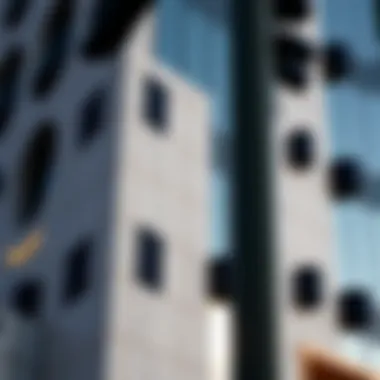

Architectural Features of Al Jaziri Building
The Al Jaziri Building represents more than just a physical structure; it's a testament to architectural vision in a rapidly transforming metropolis. Understanding its architectural features is vital, as these contribute significantly to its status and appeal within Dubai's skyline. The interplay of design aesthetics and structural innovations not only captivates the eye but also enhances the functional use of space, catering to both residents and businesses alike.
Design Aesthetics
The design of the Al Jaziri Building leans heavily into the realm of modernism while still reflecting subtle nods to traditional Middle Eastern architecture. This blend creates a unique visual experience that is instantly recognizable. The façade is wrapped in stunning glass panels, allowing natural light to flood the interiors while offering panoramic views of the city.
- Visual Harmony: The sleek lines and geometric shapes complement the surrounding architecture. This harmony aids in making the building feel like a cohesive part of the Dubai skyline rather than an isolated entity.
- Cultural Resonance: Features such as intricate mashrabiya elements are thoughtfully integrated into the design, echoing the cultural heritage of the UAE. These features serve not only as aesthetic additions but enhance airflow and privacy.
- Adaptive Color Palette: The exterior colors shift subtly with the changing Dubai sunlight, creating a dynamic appearance that varies throughout the day. This effect imbues the structure with life and character, making it engaging from multiple angles.
- Landscape Integration: The building's design carefully considers its surroundings, blending green spaces and water elements in its proximity. This not only enhances its beauty but also promotes a sense of community and connectivity with nature.
Location and Accessibility
Understanding the location and accessibility of the Al Jaziri Building is vital for a variety of stakeholders, from investors and buyers to everyday visitors. A prime location not only enhances the aesthetic experience but also influences market value and community engagement. The Al Jaziri Building benefits from its strategic positioning in the heart of Dubai, making it a focal point in the city's architectural narrative and urban development.
Proximity to Key Landmarks
Being situated near significant landmarks is one of the prime advantages of the Al Jaziri Building. Just a stone's throw away, one can find the famous Burj Khalifa and the sprawling Dubai Mall. This proximity to iconic sites fosters a vibrant atmosphere, where tourists and locals mingle, adding life to the area.
- Cultural Institutions: The nearby Dubai Opera and the Dubai Aquarium present opportunities for cultural immersion and entertainment. These venues enhance the appeal of the Al Jaziri Building as a residential or commercial space.
- Business Hubs: With the Dubai International Financial Centre (DIFC) just around the corner, professionals and corporate entities find the location appealing for daily commute and connectivity.
This central positioning not only adds a layer of prestige to the Al Jaziri Building but also promises potential buyers and renters a dynamic lifestyle filled with options for leisure and business.
Transportation Networks
Accessible transportation networks around the Al Jaziri Building also play a significant role in its desirability. Dubai boasts one of the most advanced public transportation systems in the world, and the Al Jaziri Building is excellently linked.
- Metro Stations: The nearest metro station is less than a kilometer away, making it a hub for commuters. The Dubai Metro, known for its punctuality and coverage, connects various key areas, ensuring that residents and businesses around the Al Jaziri Building remain well-connected.
- Bus Services: The extensive bus network serves as a supplementary mode of transport, providing numerous routes that connect travelers to surrounding neighborhoods and business districts.
- Road Access: The building is also conveniently situated near major roadways, including Sheikh Zayed Road. This direct access affirms that commuting, whether driving or using ride-hailing services, is both swift and convenient.
In summary, the Al Jaziri Building is not just an architectural marvel; it's built in a highly desirable location. Its proximity to landmarks combined with excellent transport options makes it appealing for investment and daily life.
Real Estate Market Implications
Examining the Al Jaziri Building's impact on the real estate market offers a valuable lens into both current trends and future possibilities in Dubai. As a focal point of architectural excellence, this structure influences not only the aesthetics of its surroundings but also the broader market dynamics within which it exists.
Investment Potential
For investors, understanding the investment potential associated with the Al Jaziri Building is imperative. This building stands as a testament to Dubai's commitment to innovative design and premium living spaces. Investors are drawn to properties that signify stability and growth, and Al Jaziri fits that bill.
The demand for high-quality residential and commercial spaces continues to burgeon in Dubai. With its strategic location close to major urban centers and recreational hubs, this building promises potentially attractive returns. Investors can expect:
- Compilation of Historical Data: Analyzing past performance trends can reveal patterns that inform future investments. Studies have shown that areas around iconic buildings often see property values soar.
- Embedded Community Value: When you buy here, you’re not just investing in a building; you’re tapping into a lifestyle that appeals to expatriates and locals alike, ensuring high demand.
- Government Initiatives: Dubai's government often supports development zones, and properties like Al Jaziri benefit from these policies, making them more appealing to seasoned investors.
Market Trends
Delving into the market trends surrounding the Al Jaziri Building provides critical insights into the evolving landscape of Dubai's real estate. Recent years have ushered in a demand shift as residents and investors alike lean more toward sustainable developments and community-centric spaces. Key trends to observe include:
- Rise of Sustainability: With a growing emphasis on eco-friendly living, buildings that incorporate energy-efficient designs or smart technologies often see faster sales and higher valuation. Al Jaziri is no exception, as its design prioritizes sustainability aspects.
- Shift in Buyer Demographics: Expats, overseas investors, and affluent local buyers are increasingly favoring properties that offer both quality and convenience in urban life. This trend positions Al Jaziri advantageously in attracting a diverse mix of residents.
- Rental Market Dynamics: Demand for rental properties remains strong, particularly in well-located, premium buildings. Al Jaziri's distinctive architectural elements make it a prime option for tenants seeking luxury.
"The value of property is often tied not just to its structure but also to the lifestyle it embodies."
Understanding these dimensions—investment potential and market trends—sheds light on Al Jaziri's role as more than a mere building. It is a vital component in a larger narrative of urban development, embodying the zeitgeist of a city that is always on the move. This narrative unfolds within a context where property values continually adapt and evolve, providing a solid foundation for discerning investors, agents, and buyers to make informed decisions.
Community and Lifestyle
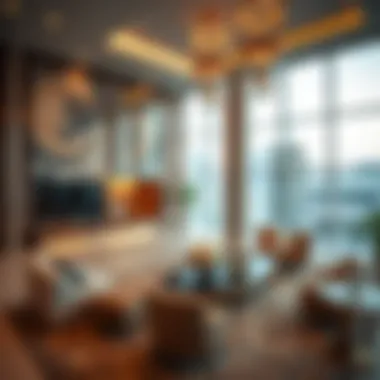

The Al Jaziri Building is not only a marvel of architectural ingenuity, but it also stands as a vibrant hub of community life in Dubai. Understanding the nuances of community and lifestyle around this iconic structure unveils the layers of connectivity, comfort, and culture that make living near the Al Jaziri Building a unique experience. The area surrounding the building encapsulates the essence of modern urban living, offering a blend of amenities and cultural richness that attracts a variety of residents, including expatriates, investors, and families.
Residential Amenities
When it comes to residential amenities, few locations can rival the offerings near the Al Jaziri Building. The architectural design has paired well with the surrounding services, creating a living space that is both practical and appealing.
- Convenience Stores and Supermarkets: Residents benefit from a plethora of shopping options, ensuring that daily needs are met without extensive travel. Local markets and sleek supermarkets, such as Carrefour and Spinneys, provide a diverse range of products.
- Dining Options: Whether for a casual bite or a gourmet dining experience, the variety of restaurants nearby, including popular spots like Zahr El-Laymoun and Café Gourmet allow residents to indulge their culinary cravings.
- Recreational Facilities: Health and fitness centers, parks, and walking trails are peppered throughout the community, encouraging an active lifestyle. The nearby Al Jazeera Park, for instance, is a favorite for morning jogs and evening strolls.
- Educational Institutions: Families with children can appreciate proximity to reputable schools and early childhood centers, making education accessible and convenient.
These amenities not only enhance the quality of life for residents but also elevate the property’s value and appeal to potential investors.
Cultural Influences
The Al Jaziri Building is nestled within a rich tapestry of multiculturalism that defines Dubai. The cultural influences here are palpable and contribute significantly to the community's character.
- Multicultural Events: The community is vibrant with various cultural festivals stemming from its diverse population. Festivals like Diwali, Eid al-Fitr, and even Chinese New Year see overwhelming support from residents irrespective of their backgrounds. Events at the Dubai Opera, located fairly nearby, further enrich the local cultural scene.
- Art and Aesthetics: The integration of art is evident in public spaces surrounding the building. Murals and installations created by local artists narrate the stories of Dubai’s evolution and honor both heritage and innovation.
- Culinary Diversity: The mix of eateries reflects various global cuisines, serving as a melting pot where people can experience a slice of different cultures within a short walk.
- Community Engagement: Local initiatives seek to engage residents through recreational clubs, workshops, and art classes, fostering connections among neighbors and promoting a sense of belonging.
"Living near the Al Jaziri Building means more than just having a roof over your head; it’s about immersing oneself in a thriving community that celebrates diversity and connectivity."
Sustainability Measures
Sustainability has become a linchpin in modern architectural practices, and the Al Jaziri Building epitomizes this focus. From the outset, the integration of eco-friendly designs and energy-efficient technologies is not simply an afterthought but a fundamental facet of its construction and operation. This commitment to sustainability enhances its appeal to investors and buyers who are increasingly prioritizing green credentials in their decision-making processes.
Eco-friendly Design
The Al Jaziri Building incorporates several eco-friendly design elements that marry aesthetics with functionality. For instance, the use of sustainable materials is at the forefront of its ecological design philosophy. Utilizing locally sourced materials reduces the carbon footprint associated with transportation and promotes regional craftsmanship. Furthermore, the structure is adorned with green roofs and vertical gardens, optimizing insulation while showcasing a commitment to enhancing urban biodiversity. This greenery not only beautifies the building but also helps in reducing the urban heat island effect commonly associated with densely populated cities like Dubai.
- Some key aspects of its eco-friendly design include:
- Solar panels installed to harness energy from the sun, providing a renewable source of electricity.
- Rainwater harvesting systems that collect and recycle water, minimizing waste and conserving valuable resources.
- Smart ventilation systems designed to maximize airflow while minimizing energy consumption.
These elements together foster an environment that reflects not only a commitment to sustainability but also a forward-thinking approach in urban architectural designs.
Energy Efficiency
Energy efficiency stands as a cornerstone in the building’s overall sustainability strategy. The Al Jaziri Building adopts several energy-saving technologies that are both cost-effective and environmentally friendly. High-performance glazing minimizes heat gain while maximizing natural light, reducing the need for artificial lighting. Moreover, the building management system carefully monitors energy use and adjusts settings automatically, providing a responsive and efficient energy use environment.
"The future of architecture lies in its ability to blend functionality with ecological responsibility."
- Key features that enhance energy efficiency include:
- LED lighting throughout the building, consuming less energy and lasting significantly longer than traditional lighting.
- High-efficiency HVAC systems, which control temperature and air quality without excessive energy use.
- Insulation made from recycled materials, which provides superior thermal resistance.
These measures do not merely satisfy regulatory frameworks but actively promote long-term savings on utility bills for occupants and owners alike. The commitment to energy efficiency positions the Al Jaziri Building as a model for future investment in sustainable real estate.
In summary, the sustainability measures adopted at the Al Jaziri Building reflect a broader shift towards responsible architecture. These considerations not only align with global trends toward sustainable living but also enhance the building's marketability among a discerning clientele keen on making eco-conscious investments. Investors will find that prioritizing such elements invariably leads to increased long-term value.
Comparative Analysis
Understanding the Al Jaziri Building's role in Dubai's architectural landscape requires placing it alongside other notable structures. This comparative analysis not only highlights its uniqueness but also illustrates its relevance within the broader urban context. Analyzing the Al Jaziri Building in conjunction with other iconic buildings helps underscore its architectural significance while revealing insights into neighborhood dynamics, urban planning, and cultural expressions.
Comparison with Other Iconic Buildings
When examining the Al Jaziri Building, it is important to draw parallels with other landmark structures in Dubai, such as the Burj Khalifa and the Dubai Marina Towers. These buildings serve as beacons of modernity and innovation, each contributing to the narrative of Dubai as a global city.
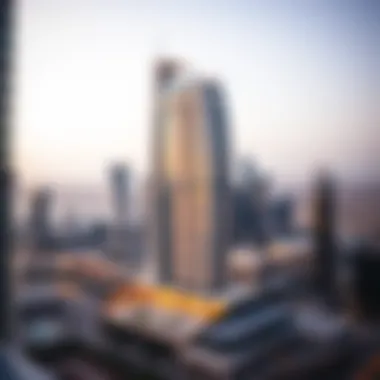

- Burj Khalifa: The tallest building in the world, Burj Khalifa symbolizes Dubai’s aspiration towards the future. While its height dominates the skyline, Al Jaziri’s unique design emphasizes fluidity and integration with its surroundings. Unlike Burj Khalifa, which stands as a solitary titan, Al Jaziri harmonizes with the community, providing a different architectural statement.
- Dubai Marina Towers: Known for their modern aesthetic and harmonious waterway views, these towers illustrate Dubai’s commitment to luxury living. Yet, unlike the Marina Towers, which focus heavily on opulence, the Al Jaziri Building embodies a balance between functionality and aesthetic appeal, showcasing a design that meets the needs of its occupants without compromising on style.
In comparing these structures, the Al Jaziri Building emerges as a more relatable choice for residents and visitors, connecting them to the city’s heritage while reflecting contemporary requirements. This comparative view enhances appreciation for Al Jaziri’s artistic approach, which melds tradition with modernity.
Impact on Neighborhood Development
The Al Jaziri Building plays a pivotal role in shaping its surrounding neighborhood, influencing urban development in several ways. As neighborhoods evolve, the presence of structures like Al Jaziri becomes vital to understanding social dynamics, economic growth, and cultural enrichment.
- Catalyst for Growth: As one of the significant buildings in the area, Al Jaziri acts as a focal point that attracts businesses and residents alike. Its architectural prominence draws attention, which often catalyzes further investment in infrastructure and amenities, adding value to the area.
- Community Engagement: The building does not just serve as a residential or commercial space; it also facilitates community events and gatherings, promoting social cohesion. This multifaceted role helps foster a sense of belonging among residents, which can be seen as a contributing factor to the neighborhood's vibrancy.
- Cultural Reflections: Furthermore, Al Jaziri exemplifies the UAE's architectural evolution. It reflects local traditions in its design while simultaneously embracing modernity, thereby influencing how newer constructions approach cultural identity.
By analyzing the Al Jaziri Building's impact on neighborhood development, we gain an understanding of how architecture influences life in urban settings. The structure stands not only as a home or workplace but as an integral part of the community, enhancing the area's social fabric and economic landscape.
"The significance of a building extends beyond its walls; it echoes the aspirations and values of the community it serves."
In summary, a comprehensive comparative analysis of the Al Jaziri Building with other iconic structures reveals its distinctive features and underscores its impact on the community. This enriches the narrative around Dubai's architectural advancements, cementing Al Jaziri's place as a key player in the city's ongoing development.
Future Prospects
The future prospects of the Al Jaziri Building play a pivotal role in understanding its place within Dubai's architectural and real estate landscape. As the demand for innovative spaces continues to rise in this bustling metropolis, the Al Jaziri Building is well-positioned to benefit from upcoming developments and shifting market dynamics. This section will delve into important upcoming projects in the vicinity as well as the long-term investment outlook that investors and potential buyers should keep in mind.
Upcoming Developments in the Area
Several budding projects around the Al Jaziri Building are expected to enhance its surroundings and overall appeal to both residents and businesses. For starters:
- Expansion of Transportation Networks: The city’s ongoing commitment to improving public transport, particularly rail systems, is likely to create easier access to and from the building. Such developments can significantly enhance property values in the area.
- New Commercial Centers: Planned commercial hubs nearby aim to attract a diverse array of retailers and services. This can foster a vibrant community atmosphere, making the Al Jaziri Building an attractive place for residents and businesses.
- Cultural Institutions: With initiatives to introduce museums and art facilities around, the area is set to become a cultural hotspot, which could provide additional allure to potential buyers and investors.
- Park and Green Spaces: The inclusion of parks is not just beneficial for recreation but also increases nearby property values. The enhancement of green belts in urban settings contributes to a higher quality of life.
Investors should keep an eye on local updates and changes, as these will directly influence the attractiveness of the Al Jaziri Building.
These developments are projected to begin within the next few years and will likely transform the landscape surrounding the Al Jaziri Building. With trends indicating a steady increase in urban development, potential investors might find themselves in a prime position.
Long-term Investment Outlook
When considering an investment in the Al Jaziri Building, a long-term perspective is essential. The property market in Dubai has historically shown resilience and growth despite fluctuations, and various factors contribute to this optimistic outlook:
- Economic Stability: The UAE has a reputation for fostering a stable economic environment. Despite global economic shifts, the country has implemented policies to ensure continued growth. Such stability can make properties like the Al Jaziri Building particularly attractive to investors.
- Rising Expat Population: The influx of expatriates continues to drive demand for housing and commercial spaces. With a diverse and growing population, the potential for increased rental yields is significant for investors.
- Government Initiatives: Programs designed to spur economic activity and tourism will likely continue to shape Dubai's real estate market. Ongoing government support for infrastructure and urban development speaks volumes about the longevity of investment in the region.
- Progressive Urbanization: As Dubai continues to modernize, properties that resonate with the avant-garde and sustainable ethos will hold their value. The Al Jaziri Building stands out for its architectural significance, placing it in a favorable position for future appreciation.
In summary, the Al Jaziri Building is more than just an architectural icon; it represents a cornerstone of future developments that can significantly benefit investors. By keeping an eye on the local market and developments, potential buyers can harness opportunities that extend beyond the immediate allure of the structure. The potential for both cultural enrichment and real estate appreciation makes the Al Jaziri Building a critical player in Dubai's promising future landscape.
The End
The Al Jaziri Building is more than just a structure of concrete and glass; it represents a melding of Dubai’s culture, history, and ambition. In analyzing the various facets of the building, including its historical context, architectural nuances, and impact on the local real estate market, we gain a comprehensive understanding of why it has become an architectural icon. Real estate investors, expatriates, and potential buyers should pay close attention to such unique structures, as they not only represent a financial opportunity but also a chance to be part of the area's evolving narrative.
Summary of Key Points
In summary, the Al Jaziri Building:
- Exhibits architectural elegance: Its design combines modern aesthetics with elements reflective of cultural heritage.
- Serves as a landmark: Its strategic location boosts accessibility and draws in visitors and residents alike, making it vital for local economic activity.
- Represents investment potential: With insights into market trends and community dynamics, it appeals to diverse buyers, from investors to families seeking new horizons.
- Focuses on sustainability: Eco-friendly practices integrated into the design ensure that the building aligns with global efforts toward a greener future.
Each of these elements contributes not just to the narrative of the Al Jaziri Building but also to the landscape of Dubai as a whole.
Final Thoughts on Al Jaziri Building
As we wrap up our exploration of the Al Jaziri Building, it is crucial to reflect on its implications beyond its walls. This structure stands as a testament to the rapid architectural development that Dubai has experienced. Yet, it is simultaneously a vessel for community engagement, offering a space that fosters connection among those who inhabit or visit it.
Investors and stakeholders should consider the Al Jaziri Building as not merely a financial asset but a piece of a larger tapestry that illustrates the growth of urban environments in the Middle East. In navigating the complexities of the real estate market, understanding the significance of such cultural icons offers an edge.
"Architecture is a visual art, and the buildings speak for themselves." Indeed, the Al Jaziri Building is a conversation starter that embodies the spirit of innovation and tradition that defines Dubai.
As the city evolves, the story of the Al Jaziri Building will unfold further, encouraging us to look towards the horizon and consider what future chapters it may inspire.

